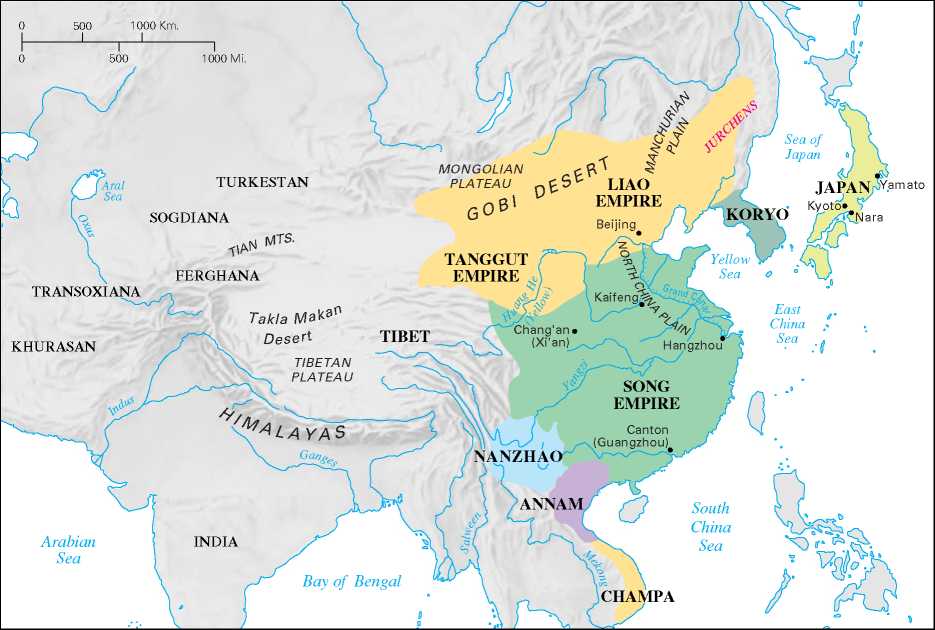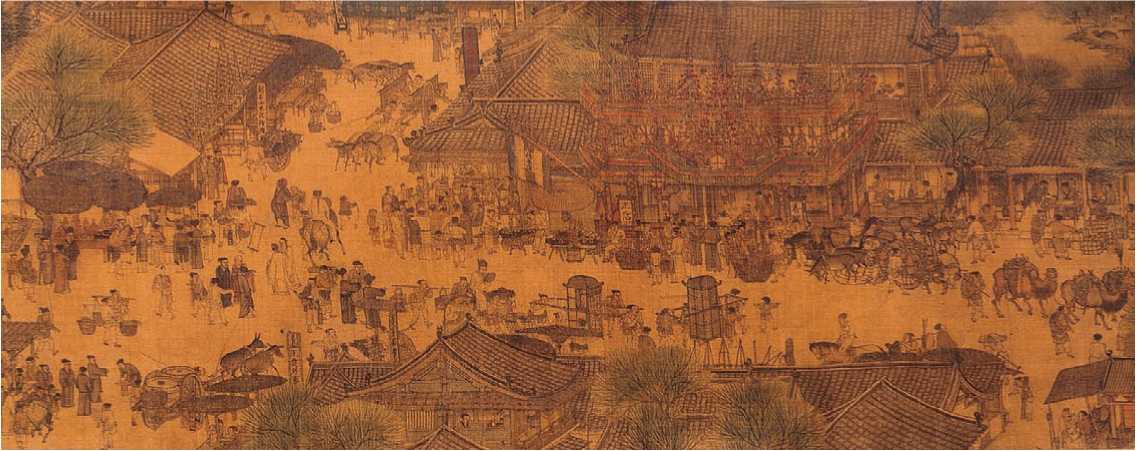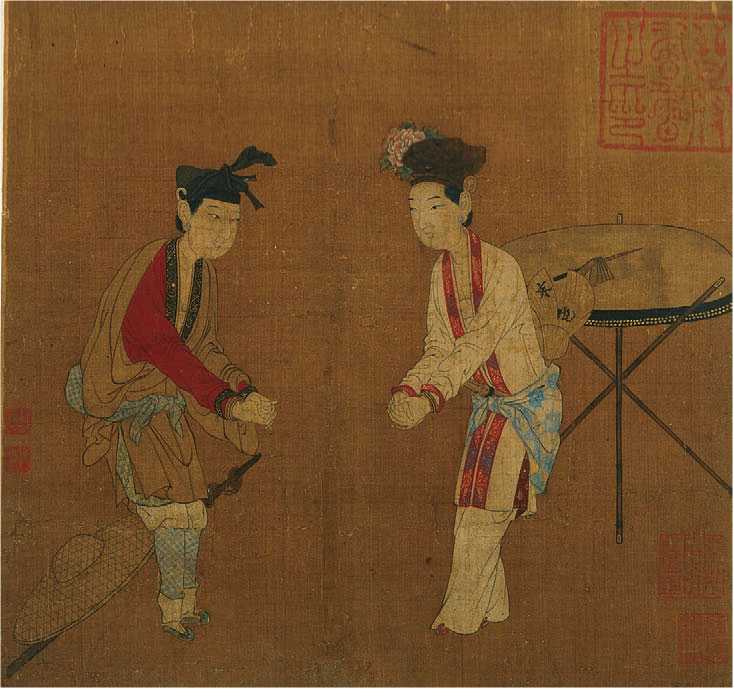In the aftermath of the Tang, three new states emerged and competed to inherit its legacy (see Map 11.2). The Liao" Empire of the Khitan" people, pastoral nomads related to the Mongols living on the northeastern frontier, established their rule in the north. They centered their government on several cities, but the emperors preferred to spend their time in their nomad encampments. In western China, the Minyak people (closely related to the Tibetans) established a second successor state. They called themselves “Tangguts"” to show their connection with the former empire. The third state, the Chinesespeaking Song Empire, came into being in 960 in central China.
Huang Chao (wang show) Beijing (bay-jeeng)
Liao (lee-OW) Khitan (kee-THAN) Tanggut (TAHNG-gut)
The Liao and Jin Challenge

Map 11.2 Liao and Song Empires, ca. 1100 The states of Liao in the north and Song in the south generally ceased open hostilities after a treaty in 1005 stabilized the border and imposed an annual payment on Song China.
9 Online Study Center
Improve Your Grade
Interactive Map:
East Asia in 1000
Competition among these states was unavoidable. They embodied the political ambitions of peoples who spoke very different languages and subscribed to different religious and philosophical systems—Mahayana Buddhism among the Liao, Tibetan Buddhism among the Tangguts, and Confucianism among the Song. The Liao and especially the Tangguts maintained some continuing relationship with Inner and Central Asia, but the Song were cut off. Instead they developed their sea connections with other states in East Asia, West Asia, and Southeast Asia. This effort led to advanced seafaring and sailing technologies. The Song elite shared the late Tang dislike of “barbaric” or “foreign” influences as they tried to cope with multiple enemies that heavily taxed their military capacities. Meanwhile, Korea and Japan strengthened political and cultural ties with China, including an appreciation of Confucianism; and some Southeast Asian states, relieved of any Tang military threat, entered into friendly relations with the Song court.
The Liao Empire of the Khitan people extended from Siberia to Central Asia, connecting China with societies to the north and west. Variations on the Khitan name became the name for China in these distant regions: “Kitai” for the Mongols, “Khitai” for the Russians, and “Cathay” for those, like contemporaries of the Italian merchant Marco Polo, who reached China from Europe (see Chapter 13).
The Liao rulers prided themselves on their pastoral traditions as horse and cattle breeders, the continuing source of their military might, and they made no attempt to create a single elite culture. In the sparsely populated northern portion of their realm (today’s Mongolia and Manchuria), the royal court moved from place to place

Map 11.3 Jin and Southern Song Empires, ca. 1200 After 1127 Song abandoned its northern territories to Jin. The Southern Song continued the policy of annual payments—to Jin rather than Liao—and maintained high military preparedness to prevent further invasions.
Following the seasons. However, they encouraged Chinese elites to use their own language, study their own classics, and see the emperor through Confucian eyes; and they encouraged other peoples to use their own languages and see the emperor as a champion of Buddhism or as a nomadic chieftain. On balance, Buddhism far outweighed Confucianism in this and other northern states, where rulers depended on their roles as bod-hisattvas or as Buddhist kings to legitimate power. Liao rule lasted from 916 to 1121.
Superb horsemen and archers, the Khitans added siege machines from China and Central Asia to their armory for challenging the Song. In 1005 the Song emperor agreed to a truce that included enormous annual payments in cash and silk to the Liao. This lasted for more than a century, but eventually the Song tired of paying the annual tribute and entered into a secret alliance with the Jurchens of northeastern Asia, who were also chafing under Liao rule. In 1115 the Jurchens destroyed the Liao capital in Mongolia and proclaimed their own empire—the Jin. Then they turned against their former Song ally (Map 11.2).
The Jurchens grew rice, millet, and wheat, but they also spent a good deal of time hunting, fishing, and tending livestock. Though their language was unrelated to that of the Khitans, the Jurchens nevertheless learned much from the Khitans about the military arts and political organization. This helped them become formidable enemies of the Song Empire, against whom they mounted an all-out campaign in 1127. They laid siege to the Song capital, Kaifeng°, and captured the Song emperor. Within a few years the Song withdrew south of the Yellow River and established a new capital at Hangzhou°, leaving central as well as northern China in Jurchen control (Map 11.3). The Song made annual payments to the Jin Empire to avoid open warfare. Historians generally refer to this period as the “Southern Song” (1127-1279).
Kaifeng (kie-fuhng) Hangzhou (hahng-jo)
Su Song's Astronomical Clock This gigantic ciock buiit at Kaifeng between 1088 and 1092 combined mathematics, astronomy, and caiendar-making with skiiifui engineering. The team overseen by Su Song piaced an armiiiary sphere on the observation piatform and iinked it with chains to the water-driven centrai mechanism shown in the cutaway view. The water wheei aiso rotated the Buddha statues in the muitistory pagoda the spectators are iooking at. Other devices dispiayed the time of the day, the month, and the year. (Courtesy, Joseph Needham, Science and Civilization in China)

„ , , . Historians look upon the
Song Industries Southern Song as the premod
Ern state and society that came closest to initiating an industrial revolution. Divided into three separate states from 907 to 1279, China did not exhibit the military expansionism and exploitation of far-flung networks of communication that had characterized the Tang at their height. Yet many of the advances in technology, medicine, astronomy, and mathematics for which the Song is famous derived from information that had come to China in Tang times, sometimes from very distant places. Song officials, scholars, and businessmen had the motivation and resources to adapt Tang information and technology to meet their needs, particularly in warfare, extension of agriculture, and the management of economic and social changes.
Chinese scholars made great strides in the arts of measurement and observation, drawing on the work of Indian and West Asian mathematicians and astronomers who had migrated to the Tang Empire in previous generations. Song mathematicians introduced the use of fractions, first employing them to describe the phases of the moon. From lunar observations, Song astronomers constructed a very precise calendar and, alone among the world’s astronomers, noted the explosion of the Crab Nebula in 1054. Chinese scholars used their work in astronomy and mathematics to make significant contributions to timekeeping and the development of the compass.
In 1088 the engineer Su Song constructed a gigantic mechanical celestial clock in Kaifeng. Escapement mechanisms for controlling the revolving wheels in water-powered clocks had appeared under the Tang, as had the application of water wheels to weaving and threshing. But this knowledge had not been widely applied. Su Song adapted the escapement and water wheel to his clock, which featured the first known chain-drive mechanism. The clock told the time of day and the day of the month, and it indicated the movement of the moon and certain stars and planets across the night sky. An observation deck and a mechanically rotated armillary sphere crowned the 80-foot (24-meter) structure. The clock exemplified the Song ability to integrate
Economy and Society in Song China
Observational astronomy, applied mathematics, and engineering.
Song inventors drew on their knowledge of celestial coordinates, particularly the Pole Star, to refine the design of the compass. Long known in China, the magnetic compass shrank in size in Song times and gained a fixed pivot point for the needle, and sometimes even a small protective case with a glass covering. These changes made the compass suitable for seafaring, a use first attested in 1090. The Chinese compass and the Greek astrolabe, introduced later, improved navigation throughout Southeast Asia and the Indian Ocean.
Development of the seaworthy compass coincided with new techniques in building China’s main oceangoing ship, the junk. A stern-mounted rudder improved the steering of the large ship in uneasy seas, and watertight bulkheads helped keep it afloat in emergencies. The shipwrights of the Persian Gulf soon copied these features in their ship designs.
Song innovation carried over into military affairs as well, though military pressure from the Liao and Jin Empires remained a serious challenge. The Song fielded an army four times as large as that of the Tang—about 1.25 million men (roughly the size of the present-day army of the United States)—though it occupied less than half the territory of the Tang. Song commanders were specially educated for the task, examined on military subjects, and paid regular salaries.
Because of the need for iron and steel to make weapons, the Song rulers fought their northern rivals for control of iron and coal mines in north China. The volume of Song mining and iron production, which again became a government monopoly in the eleventh century, soared. By the end of that century cast iron production reached about 125,000 tons (113,700 metric tons) annually, putting it on a par with the output of eighteenth-century Britain. Engineers became skilled at high-temperature metallurgy. They produced steel weapons of unprecedented strength by using enormous bellows, often driven by water wheels, to superheat the molten ore. Military engineers used iron to buttress defensive works because it was impervious to fire or concussion. Armorers used it in mass-produced body armor (in small, medium, and large sizes). Iron construction also appeared in bridges and small buildings. Mass-production techniques for bronze and ceramics in use in China for nearly two thousand years were adapted to iron casting and assembly.
To counter cavalry assaults, the Song experimented with gunpowder, which they initially used to propel clusters of flaming arrows. During the wars against the Jurchens in the 1100s the Song introduced a new and terrifying weapon. Shells launched from Song fortifications exploded in the midst of the enemy, blowing out shards of iron and dismembering men and horses. The short range of the shells limited them to defensive uses, and they had no major impact on the overall conduct of war.
Despite the continuous military threats and the vigor of Song responses, Song elite culture idealized civil pursuits. Socially, the civil man outranked the military man. Private academies, designed to train young men for the official examinations and develop intellectual interests, became influential in culture and politics. New interpretations of Confucian teachings became so important and influential that the term neo-Confucianism is used for Song and later versions of Confucian thought.
Zhu Xi° (1130-1200), the most important early neo-Confucian thinker, wrote in reaction to the many centuries during which Buddhism and Daoism had often overshadowed the precepts of Confucius. He and others worked out a systematic approach to cosmology that focused on the central conception that human nature is moral, rational, and essentially good. To combat the Buddhist dismissal of worldly affairs as a transitory distraction, they reemphasized individual moral and social responsibility. Their human ideal was the sage, a person who could preserve mental stability and serenity while dealing conscientiously with troubling social problems. Where earlier Confucian thinkers had written about sage kings and political leaders, the neo-Confucians espoused the spiritual idea of universal sagehood, a state that could be achieved through proper study of the new Confucian principles and cosmology.
Despite the vigor and pervasiveness of neo-Confucianism, popular Buddhist sects persisted during the Song. The excerpt from a Song song-story quoted at the beginning of this chapter contained the line “We Buddhists and Confucians are of one family.” While historically suitable for the time when the original version of the story of Ying-ying was written, before the Tang abolition of the Buddhist monasteries in 840, it is unlikely that the line would have pleased a Song audience if anti-Buddhist feelings had remained so ferocious. Some Buddhists elaborated upon Tang-era folk practices derived
Zhu Xi (jew she) from India and Tibet. The best known, Chan Buddhism (known as Zen in Japan and as Son in Korea), asserted that mental discipline alone could win salvation.
Meditation, a key Chan practice, could be employed by Confucians as well as Buddhists. It could afford prospective officials relief from their preparation for civil service examinations, which continued into the Song from the Tang period. Dramatically different from the Han policy of hiring and promoting on the basis of recommendations, Song-style examinations persisted for nearly a thousand years. A large bureaucracy oversaw their design and administration. Test questions, which changed each time the examinations were given, even though they were always based on Confu-cian classics, often related to economic management or foreign policy.
The examinations had social implications, for hereditary class distinctions meant less than they had in Tang times, when noble lineages played a greater role in the structure of power. The new system recruited the most talented men for government service, whatever their origin. Men from wealthy families, however, succeeded most often. The tests required memorization of classics believed to date from the time of Confucius; preparation consumed so much time that peasant boys could rarely compete.
Success in the examinations brought good marriage prospects, the chance for a high salary, and enormous prestige. Failure could bankrupt a family and ruin a man both socially and psychologically. This put great pressure on candidates, who spent days at a time in tiny, dim, airless examination cells, attempting to produce their answers—in beautiful calligraphy.
Changes in printing, from woodblock to an early form of movable type, allowed cheaper printing of many kinds of informative books and of test materials. The Song government realized that the examination system schooled millions of ambitious young men in Confucian ideals of state service—many times the number who eventually passed the tests. To promote its ideological goals, the government authorized the mass production of preparation books in the years before 1000. Though a man had to be literate to read the preparation books and basic education was still not common, some people of limited means were now able to take the examinations; and a moderate number of candidates entered the Song bureaucracy without noble, gentry, or elite backgrounds.
The availability of printed books changed country life as well, since landlords now had access to expert advice on planting and irrigation techniques, harvesting, tree cultivation, threshing, and weaving. Landlords frequently gathered their tenants and workers to show them illustrated texts and explain their meaning. This dissemination of knowledge, along with new technologies, furthered the development of new agricultural land south of the Yangtze River. Iron implements such as plows and rakes, first used in the Tang era, were adapted to wet-rice cultivation as the population moved south. Landowners and village leaders learned from books how to fight the mosquitoes that carried malaria. Control of the disease became one of the factors encouraging northerners to move south, which led to a sharp increase in population.
The increasing profitability of agriculture caught the attention of some ambitious members of the gentry. Still a frontier for Chinese settlers under the Tang, the south saw increasing concentration of land in the hands of a few wealthy families. In the process, the indigenous inhabitants of the region, related to the modern-day populations of Malaysia, Thailand, and Laos, retreated into the mountains or southward toward Vietnam.
During the 1100s the total population of the Chinese territories, spurred by prosperity, rose above 100 million. An increasing proportion lived in large towns and cities, though the leading Song cities had fewer than a million inhabitants. This still put them among the largest cities in the world.
Health and crowding posed problems in the Song capitals. Multistory wooden apartment houses fronted on narrow streets—sometimes only 4 or 5 feet (1.2 to 1.5 meters) wide—that were clogged by peddlers or families spending time outdoors. The crush of people called for new techniques in waste management, water supply, and firefighting. Controlling urban rodent and insect infestations improved health and usually kept the bubonic plague isolated in a few rural areas.
In Hangzhou engineers diverted the nearby river to flow through the city, flushing away waste and disease. Arab and European travelers who had firsthand experience with the Song capital, and who were sensitive to the urban crowding in their own societies, expressed amazement at the way Hangzhou city officials sheltered the densely packed population from danger so that they could enjoy the abundant pleasures of the city: restaurants, parks, bookstores, wine shops, tea houses, theaters, and the various entertainments mentioned at the start of this chapter.
The idea of credit, originating in the robust long-distance trade of the Tang period, spread widely under the Song. Intercity or interregional credit—what the Song called “flying money”—depended on the acceptance of guarantees that the paper could be redeemed for coinage

Going up the River Song cities hummed with commercial and industrial activity, much of it concentrated on the rivers and canals linking the capital Kaifeng to the provinces. This detail from Going Upriver at the Qingming [Spring] Festival shows a tiny portion of the scroll painting's panorama. Painted by Zhang Zeduan sometime before 1125, its depiction of daily life makes it an important source of information on working people. Before open shop fronts and tea houses a camel caravan departs, donkey carts are unloaded, a scholar rides loftily (if gingerly) on horseback, and women of wealth go by in closed sedan-chairs. (The Palace Museum, Beijing)
At another location. The public accepted the practice because credit networks tended to be managed by families, so that brothers and cousins were usually honoring each other’s certificates.
“Flying money” certificates differed from government-issued paper money, which the Song pioneered. In some years, military expenditures consumed 80 percent of the government budget. The state responded to this financial pressure by distributing paper money. But this made inflation so severe that by the beginning of the 1100s paper money was trading for only 1 percent of its face value. Eventually the government withdrew paper money and instead imposed new taxes, sold monopolies, and offered financial incentives to merchants. Privatization created opportunities for individuals with capital to engage in businesses that previously had been state monopolies.
Hard-pressed for the revenue needed to maintain the army, canals, roads, waterworks, and other state functions, the government finally resorted to tax farming, selling the rights to tax collection to private individuals. Tax farmers made their profit by collecting the maximum amount and sending an agreed-upon smaller sum to the government. This meant exorbitant rates for taxable services, such as tolls, and much heavier tax burdens on the common people.
Rapid economic growth undermined the remaining government monopolies and the traditional strict regulation of business. Now merchants and artisans as well as gentry and officials could make fortunes. With land no longer the only source of wealth, the traditional social hierarchy common to an agricultural economy weakened, while cities, commerce, consumption, and the use of money and credit boomed. Urban life reflected the elite’s growing taste for fine fabrics, porcelain, exotic foods, large houses, and exquisite paintings and books. Because the government and traditional elites did not control much of the new commercial and industrial development, historians sometimes describe Song China as “modern,” using the term to refer to the era of private capitalism and the growth of an urban middle class in eighteenth-century Europe.
In conjunction with the backlash against Buddhism and revival of Confucianism that began under the Tang
The Players Women—often enslaved—entertained at Chinese courts from early times. Tang art often depicts women with slender figures, but Tang taste also admired more robust physiques. Song women, usually pale with willowy fi'gures, appear as here with bound feet. The practice appeared in Tang times but was not widespread until the Song, when the image of weak, housebound women unable to work became a status symbol and pushed aside the earlier enthusiasm for healthy women who participated in family business. (The Palace Museum, Beijing)

And intensified under the Song, women entered a long period of cultural subordination, legal disenfranchisement, and social restriction. Merchants spent long periods away from home, and many maintained several wives in different locations. Frequently they depended on wives to manage their homes and even their businesses in their absence. But though women took on responsibility for the management of their husbands’ property, their own property rights suffered legal erosion. Under Song law, a woman’s property automatically passed to her husband, and women could not remarry if their husbands divorced them or died.
The subordination of women proved compatible with Confucianism, and it became fashionable to educate girls just enough to read simplified versions of Con-fucian philosophy that emphasized the lowly role of women. Modest education made these young women more desirable as companions for the sons of gentry or noble families, and as literate mothers in lower ranking families aspiring to improve their status. Only rarely did a woman of extremely high station with unusual personal determination, as well as uncommon encouragement from father and husband, manage to acquire extensive education and freedom to pursue the literary arts. The poet Li Qingzhao° (1083-1141) acknowledged and made fun of her unusual status as a highly celebrated female writer:
Although I’ve studied poetry for thirty years
I try to keep my mouth shut and avoid reputation.
Now who is this nosy gentleman talking about my poetry
Like Yang Ching-chih°
Who spoke of Hsiang Ssu° everywhere he went.5
Her reference is to a hermit poet of the ninth century who was continually and extravagantly praised by a court official, Yang Ching-chih.
Li Qingzhao (lee CHING-jow) Hsiang Ssu (sang sue)
Yang Ching-chih (yahng SHING-she)
Female footbinding first appeared among slave dancers at the Tang court, but it did not become widespread until the Song period. The bindings forced the toes under and toward the heel, so that the bones eventually broke and the woman could not walk on her own. In noble and gentry families, footbinding began between ages five and seven. In less wealthy families, girls worked until they were older, so footbinding began only in a girl’s teens.
Many literate men condemned the maiming of innocent girls and the general uselessness of footbinding. Nevertheless, bound feet became a status symbol. By 1200 a woman with unbound feet had become undesirable in elite circles, and mothers of elite status, or aspiring to such status, almost without exception bound their daughters’ feet. They knew that girls with unbound feet faced rejection by society, by prospective husbands, and ultimately by their own families. Working women and the indigenous peoples of the south, where northern practices took a longer time to penetrate, did not practice footbinding. As a consequence, they enjoyed considerably more mobility and economic independence than did elite Chinese women.




 World History
World History









